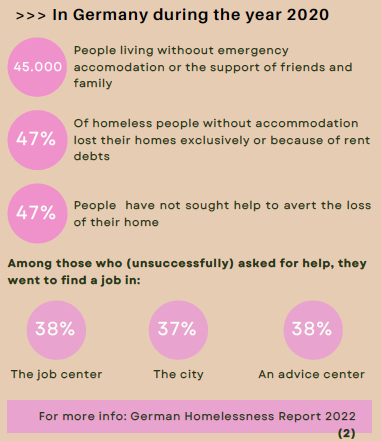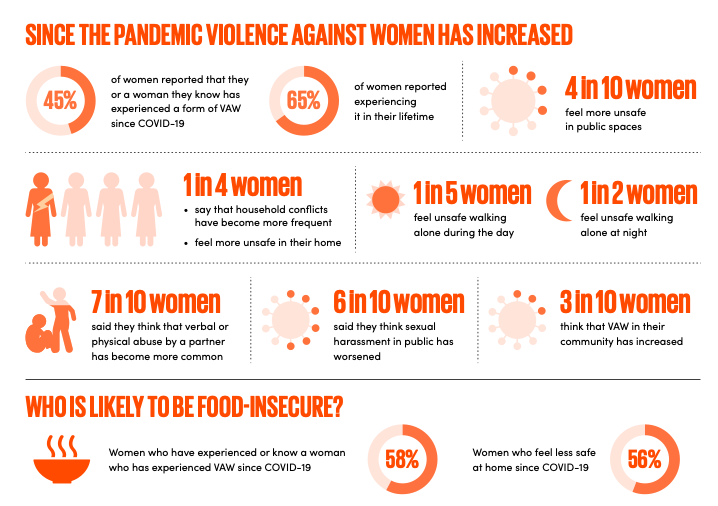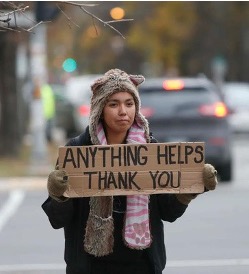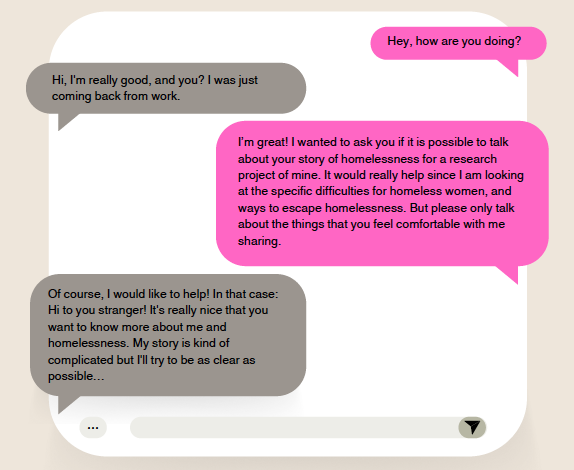Introduction
Imagine someone woke you up in the middle of the night and demanded to know where you were four years ago. We are pretty sure what your answer would be, because in March 2020, most of us were at home for the majority of the time.
Spring of 2020 was a time when the world was turned upside down by the coronavirus, your life was probably in some way affected as well. Most people faced challenges, but could at least deal with them in the comfort of their own home.
About us
We, that is Garance and Lena. Both of us also don’t remember where we’ve exactly been 4 years ago, but what we know for sure is that we’ve spent our time mostly in our pajamas at home.

Lena was studying political science at the Leuphana in Lüneburg and now is doing an internship in Berlin. During the pandemic, she started to work in a kitchen, serving hot meals for the homeless population.
Garance is studying here in Lüneburg for one year but then she’ll go back to France after that to finish her Bachelor’s in political sciences. During the lockdown, she watched the entire 5 seasons of Peaky Blinders in one week (don’t judge we all have done things like this).

Even though everybody probably remembers the time a bit differently, we are sure that many people shared a certain feeling of hopelessness during these times. Research on the impact of this global pandemic on everyday lives is in the early stage since the world is still recovering from that. What is safe to say is that the comfort of your own home is an essentail commodity, providing health and safety- that is, if you had a home. Because during that time, the increasing importance of your own home affected especially those, who didn’t have one before. The homeless.
How should the imperative of „stay at home“ work if you have none? And how should you be able to quarantine, if there is no space to isolate yourself? In this blog, we want to look at how homeless people were affected by this pandemic and the following lockdown. We will also explore more deeply the impacts of the pandemic on women which potentially led them into homelessness.
We won’t be going into detail on the covid crisis (1). We’ve all been there, done that and we think we have enough memories from that time.

Homelessness in Germany (Lena)
>>> HOMELESSNESS STAGGERING FIGURES
If I, Lena, walk through the streets of Berlin, I am very often confronted with homelessness since many people are sitting on the sidewalk or in the subway stations, begging for money or any other form of support. Most of them, I suppose, don’t have a home, and I often wonder how hard it must be to live on the streets, especially in winter, when it can quickly become -10°C at night. I can’t imagine the mental and physical hardships that homeless people go through. The state-subsidized support to help homeless people into a more self-determined life is just as important as the factors behind homelessness are complex.
Since the pandemic and lockdown startet in early 2020, many people were looking with concern at homeless people in their city, wondering how they will keep up, when emergency accommodations were shutting down as well. The facts are quite clear: Both in Germany and the US, the number of homeless people increased over the pandemic.


It also finds that general living conditions for homeless people worsened during the pandemic since homeless people found it difficult to protect themselves from infection due to the welfare state framework and were affected by psychological and financial burdens.
The homelessness support system had to restrict or reduce social services and offers, maintain or renew them under difficult conditions, and modify them, especially at the beginning of the pandemic and during the lockdowns.
>>> THE “ SHADOW PANDEMIC”
I could also see that while working in an emergency kitchen and shelter for homeless people during the spring of 2020 in Hamburg. What was also very obvious to see were the differences between men and women and how they became homeless in the first place. Women are hereby fighting a specific battle, often escaping domestic violence and toxic relationships at home. They often then become victims of violence on the street as well, trying to fight their trauma with nowhere to go. UN Women finds that the number of homeless women increased disproportionately during lockdown.
Calling it the “Shadow Pandemic”, they collected a lot of emerging data on the gendered consequences of the pandemic, stating that violence against women (and non-binary or trans people as well) has definitely intensified since the outbreak of Covid-19 (3).

In Germany, domestic violence as well as an unsafe housing situation are the main reasons why women are particularly affected by homelessness. There are still not enough shelters, especially for homeless women, and the housing market is also extremely difficult for single people, due to rising rents and demands.
About 59.000 women were homeless in Germany in 2020 and we have to expect a large number of unreported cases, raising the number even more. Some of thewomen can escape the streets by staying over at a friend’s place, which is a common phenomenon among homeless women. In this case, we speak of „hidden homelessness“, which is more commonamong women than men. It is also a reason why it is commonly believed that women are less oftenaffected by homelessness, although the opposite is actually the case. But even when women can stay overnight at a friend’s place, the risk of falling into new dependencies is very high for them. Some even have to prostitute themselves to find a place to stay overnight with a stranger, which obviously reveals a new threat of violence against them (4).
>>> VARIOUS FACTORS
Another reason for rising homelessness for women is that women-dominated industries, such as the small-business service sector, are being specifically impacted by the economic slowdown due to COVID-19, as the Georgetown Institute for Women, Peace and Security finds. For women and girls, unsheltered homelessness is even less safe, since they are often subjected to more violence, and cannot afford enough food or hygienic products, which then leads to severe illnesses or period poverty, where menstruating people cannot afford hygienic products for their monthly menstrual cycle (5).
All of this information can leave you quite frustrated with the whole situation; at least, it does for me. I then do what I do most of the time when I feel overwhelmed and can’t really find a way out. I call one of my friends.
I think it will be interesting to compare the situation with another country like the US. Would you like to know how it is there? I know a friend, Joyce, from an association who can explain to us the situation because she was a young homeless woman in the U.S., and now she has a flat and a stable job.



Homelessness in the US (Garance)
>>> JOYCE EXPERIENCE IN FLORIDA
Well, I don’t really know where to start now. Maybe with this stupid virus called COVID 19 which turned my life upside down in 2020 like the life of many other women.
I was only 17 years old and going to high school in Gainesville (Florida), my family wasn’t that healthy and the end of the months were very difficult financially. My mother was a nurse on swing shift (6) and my father lost his job and was not doing anything at home.
The closures of schools affected over 1.6 billion students in over 190 countries at the peak of the pandemic. While the disruptions impacted all students, girls and young women were disproportionately affected (7).
The after-effect of my school´s closure was that we didn’t have enough internet at home for me to follow the classes. Things were already precarious, and my parents couldn’t afford high speed internet. So, when my school closed, I couldn’t keep up with my classes. That made me part of the 14% of girls who quit school without a high school diploma.
I lived in Gainesville at that period of my life and homelessness in the US was a challenge for the government because tracking COVID-related population changes proved difficult. The pandemic disrupted data collection in 2021. In 2022, the Point-in-Time (PIT) count showed that the number of homeless people had increased, but only by 0.3 per cent. This is a relatively small increase despite the major crisis that has taken place (8).

>>> SOLUTIONS FOR JOYCE
But I was one of those homeless women, outside alone without a shelter. Fortunately, I had the chance to meet someone from the HomelessService Network of Central Florida and their service Housing First (9). They helped me to gain confidence in myself again by having a shelter.
Personally, I didn’t benefit from federal policies but I know friends that I met later, did, and it helpedmany people. Eviction moratoria and the federal Emergency Rental Assistance (ERA) program kept (and are still keeping) many people housed. Additional investments were made in homeless assistance and housing vouchers targeted to people impacted by homelessness (8).


CONCLUSION
(GARANCE & LENA)
>>> WHAT DID WE LEARN ?
I hang up the phone and take a deep breath in. I am so happy for Joyce and how she got her life back together through efficient support systems for homeless people. After all, not everything seems to be so bad.
So, what did we learn from this phone call? In essence, it captures the personal struggles of women amidst the COVID-19-induced homelessness crisis. Hearing from a person who has directly suffered under homelessness and all the consequences thereof, reveals the urgent need for supportive state systems to fight homelessness- not just in the US, but also here in Germany. Luckily, there are already some great initiatives in both states, which gives hope, even if they are not enough.
>>>> SOLUTIONS IN BOTH COUNTRIES
In Germany, the project Karla 51 for example, is a great project which offers emergency reception and counseling, exclusively for homeless women (with and without children) (10). In the US the initiative is taken by the service Housing First which welcomes everyone .



